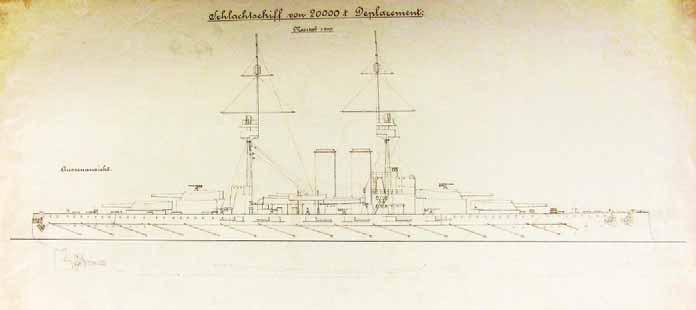the displacement of this ship would exceed 9,500 tons. The admirals, Ripper and Mauler voted for the uniform 19 cm armament.77 At the board meeting of 3 November 1905 Linienschiffskapitän von Schwarz proposed a 28 cm main battery. Kontreadmiral Kailer supported the variant B with two more 19 cm guns. There was no formal decision on the armament of the armored cruiser at this meeting,78 and no other documents related to the design of the Rammkreuzer F are found in the Kriegsarchiv Vienna. Very little is known about the fate of the project of the fourth Austro-Hungarian armored cruiser. On the exemplar of the fleet plan of summer 1905 found in the Kriegsarchiv the displacement of the armored cruiser was modified by hand from 8,000 to 10,000 tons.79 The armored cruiser was cancelled during 1906. The budget proposals for 1907 presented to the delegations at the end of 1906 contained only the three 14,500 ton battleships and the Kreuzer F, a 3,500 ton scout cruiser, the first steam turbine powered vessel of the Austro-Hungarian Navy. A document written in 1908 contains a reference to the fate of the armored cruiser: she lost her importance thanks to the bad financial situation of the Navy.80 There is an interesting and not widely known episode related to the projected armored cruiser. When Marinekommandant Admiral Spaun resigned in 1904 thus protesting against budgetary restrictions the respectful Emperor Franz Joseph ordered on 5 October 1904 to name the Navy’s next ship after Spaun. Originally the vessel named after the resigned Marinekommandant would have been the projected armored cruiser. In March 1908, well after the cancellation of the armored cruiser Montecuccoli proposed the Emperor to name the Kreuzer F under construction in Pola after Spaun. The Emperor accepted Montecuccoli’s proposal.81 SMS Admiral Spaun launched in October 1909 was the first turbine powered light cruiser of the Austro-Hungarian Navy. Financial and Political Background As it was mentioned, the extraordinary credit of 120 million Kronen voted for the Navy in 1904 allowed only the acceleration of the construction of the Erzherzog Karl class battleships. The credit
also provided a figure of 34 million Kronen for the long time needed building of new destroyers and torpedo boats (Huszár and Kaiman classes). After the resignation of Spaun in October 1904 the new Marinekommandant, Admiral Rudolf von Montecuccoli had the task of providing the funding for the new battleships. To pave the way for the new battleships, Montecuccoli presented a memorandum with his fleet program to the Emperor in the summer of 1905. The Marinekommandant named Italy the main enemy of the Dual Monarchy. He envisioned a certain future Austro-Hungarian defeat at the sea if the replacement of the obsolete capital ships would not have been done. Montecuccoli wrote that Italy enjoyed a 2.5-fold superiority in battleships and 3.5-fold superiority in destroyers and torpedo boats over Austria-Hungary, and the Italian naval budget was twice as big as the Austro-Hungarian. He stated furthermore, that the Navy in its existing state was weaker than in the time of the Battle of Lissa and was only able to defend its ports; but he warned not doing that pointing out to the fate of the Russian fleet at Port Arthur. Montecuccoli listed other arguments for the long-term development of the Navy: growing overseas interests and the need of keeping the great power status of the Dual Monarchy.82 The memorandum contained a fleet program of twelve battleships, four armored cruisers, eight smaller cruisers, eighteen destroyers, thirty-six seagoing torpedo boats, forty-eight coastal torpedo boats and six submarines. In the text of the memorandum written by typewriter the displacements of the new battleships, armored cruiser and cruiser were modified by hand, from 13,000 to 14,000 tons, from 8,000 to 10,000 tons and from 3,000 to 3,500 tons. The program prescribed that no battleship could be older than twenty years. Montecuccoli made clear that in the next four years they should build the new battleship class to replace the old casemate ship Tegetthoff (1878) and the turret ships Kronprinz Rudolf and Kronprinzessin Stephanie (1887). The Marinekommandant asked 30.7 million Kronen for 1907 to start the construction of the new battleships.83 The total cost of the three battleships was 118 million Kronen. Unfortunately for the Navy the delegations could not meet in 1905 due to the Hungarian political crisis. The unified opposition won the 1905
— 42 —






























